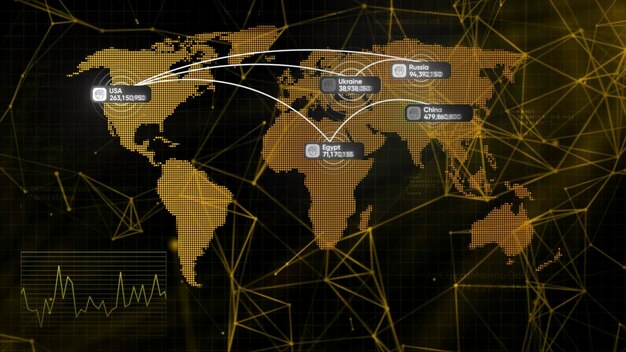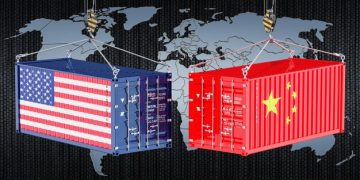US Trade Policy Shift Decoding: Key Changes & Export Implications

The latest shifts in US trade policy reflect a strategic recalibration toward national interests and economic security, impacting American exporters through new tariff structures, enhanced supply chain resilience initiatives, and revised international trade agreements, demanding adaptable export strategies.
Understanding the intricate dynamics of global commerce requires a keen eye on policy shifts, especially when they emanate from major economic players like the United States. This article delves into decoding the latest US trade policy shift: 3 key changes and their implications for American exporters, offering insights grounded in thorough analysis rather than superficial observations.
The Geopolitical Underpinnings of Recent Policy Alterations
The recent evolution of US trade policy is not an isolated phenomenon but rather a response to a complex interplay of geopolitical pressures, domestic economic priorities, and evolving international relations. A nuanced understanding begins by examining the philosophical shifts informing these new approaches, moving away from purely free-market ideologies towards more targeted, strategic interventions. This includes a growing emphasis on national security concerns and the weaponization of economic tools to achieve foreign policy objectives.
The geopolitical landscape has undeniably become more volatile, marked by increased great power competition and regional conflicts. This environment compels nations to reassess their vulnerabilities, particularly concerning supply chains for critical goods such as semiconductors, rare earth minerals, and pharmaceutical components. The concept of “friend-shoring” or “ally-shoring” has emerged as a direct consequence, aiming to reduce dependence on potential adversaries and strengthen economic ties with trusted partners.
Supply Chain Resilience and Strategic Autonomy
One of the most profound shifts in US trade policy revolves around enhancing supply chain resilience and fostering strategic autonomy. The COVID-19 pandemic starkly exposed the fragilities of highly interconnected global supply chains, leading to shortages and economic disruptions. This experience catalyzed a policy push to onshore or nearshore production of essential goods and diversify sourcing away from single points of failure. The objective is not merely to bring jobs back to American soil but also to secure access to vital materials and components during times of crisis or geopolitical tension.
- Encouraging domestic manufacturing through incentives and subsidies.
- Diversifying sourcing routes to reduce reliance on specific nations.
- Investing in critical infrastructure to support resilient supply networks.
- Collaborating with allies to build robust alternative supply chains.
This strategic autonomy initiative places additional layers of considerations for American exporters. They must now navigate a landscape where sourcing decisions are increasingly influenced by national security imperatives rather than purely economic efficiencies. Companies that can demonstrate robust and diversified supply chains are likely to be viewed more favorably, both by the government and by their international partners.
Moreover, the emphasis on strategic autonomy has a direct bearing on export control policies. Technologies deemed critical for national security, such as advanced computing, artificial intelligence, and biotechnology, face stricter export regulations. This is designed to prevent sensitive know-how and materials from falling into the hands of competitors or adversaries, safeguarding America’s technological edge. Exporters in these high-tech sectors must invest significantly in compliance frameworks to avoid penalties and maintain market access.
Responding to Unfair Trade Practices
Another significant undercurrent of the latest policy shifts is a more assertive stance against what the US perceives as unfair trade practices by other nations. This includes issues such as intellectual property theft, forced technology transfers, industrial subsidies, and non-market economies. The US government is increasingly willing to employ a range of tools, including tariffs, sanctions, and anti-dumping duties, to counter these practices and level the playing field for American businesses.
This renewed assertiveness signals a departure from purely multilateral approaches to trade disputes, often favoring bilateral negotiations or unilateral actions when deemed necessary. American exporters may find themselves operating in an environment where trade remedies are more frequently utilized, potentially creating both opportunities and challenges. While designed to protect domestic industries, these measures can sometimes lead to retaliatory tariffs from affected nations, impacting export competitiveness.
The Evolution of Tariff Structures: A Closer Look
One of the most tangible manifestations of the shifting US trade policy is the evolution of tariff structures. While tariffs have always been part of the international trade toolkit, recent decades saw a general trend towards liberalization and reduction of trade barriers. However, the current administration has demonstrated a willingness to strategically deploy tariffs as a means to achieve various policy objectives, from protecting domestic industries to coercing changes in the trade practices of other nations.
The re-evaluation of tariff use reflects a broader strategic pivot. No longer are tariffs seen solely as revenue-generating mechanisms or temporary protective measures. Instead, they are increasingly integrated into a comprehensive foreign policy and economic strategy. This shift demands that American exporters adopt a more proactive and analytical approach to understanding how these duties impact their cost structures, competitive positioning, and market access abroad.
Targeted Tariffs and National Security
A notable change has been the move towards more targeted tariffs, often justified on national security grounds. Unlike broad-based tariffs that impact a wide range of goods, these selective duties are imposed on specific products or sectors originating from particular countries. This approach aims to address perceived threats to national security, bolster critical domestic industries, or counter predatory economic practices without causing widespread disruption to global trade flows.
- Increased scrutiny on imports of advanced technology and critical minerals.
- Tariffs imposed on goods from countries deemed to engage in unfair trade.
- Use of Section 232 investigations (national security) for steel and aluminum.
- Consideration of tariffs on green energy products to protect nascent industries.
For American exporters, understanding the rationale behind these targeted tariffs is crucial. While they may offer protection to domestic producers of certain goods, they can also invite retaliatory measures from affected foreign governments, which could then impact US exports to those markets. Companies must assess the potential for such retaliations and build resilience into their export diversification strategies.
The imposition of national security tariffs also signals a new era where economic interconnectedness is viewed through a strategic lens. This means that geopolitical risks are now explicitly factored into trade decisions, potentially leading to less predictable trade environments. Exporters should conduct thorough geopolitical risk assessments for their target markets, considering how shifts in bilateral relations might suddenly introduce new tariff barriers or non-tariff barriers.
Impact on Supply Chain Relocation
The sustained presence of certain tariffs, combined with incentives for domestic production, has begun to influence supply chain relocation decisions. Businesses are increasingly evaluating the long-term costs of operating global supply chains that span multiple jurisdictions, especially when faced with the unpredictability of tariff impositions. This has led to a cautious trend of re-shoring or near-shoring manufacturing operations, particularly for goods that face high tariff rates or are deemed strategically important.
For American exporters, this presents a dual challenge and opportunity. On one hand, higher input costs due to tariffs on imported components can erode export competitiveness. On the other hand, a more localized supply chain can offer greater stability, reduced lead times, and potentially lower logistics costs, benefiting agile exporters. Companies that can adapt their sourcing strategies to align with these domestic policy priorities may gain a competitive advantage.
Moreover, the emphasis on local content requirements within various trade agreements or domestic procurement policies can be a direct result of these tariff strategies. American exporters might find that their products are more competitive in certain markets if they incorporate a higher percentage of US-origin content, thereby leveraging the domestic policy environment to their advantage in international tenders or market entry.

Revised International Trade Agreements: A New Era of Collaboration?
Beyond tariffs, a significant shift in US trade policy concerns the approach to international trade agreements themselves. There’s a discernible move away from the pursuit of large-scale, multilateral agreements towards more focused, bilateral, or regional frameworks, with an increased emphasis on shared values and strategic alignment. This reflects a pragmatic approach, prioritizing agility and targeted outcomes over broad, often unwieldy, global consensus.
The conventional wisdom that “more trade agreements lead to more trade” is being re-evaluated in Washington. While the value of free trade is still generally acknowledged, the terms under which that trade occurs are now subject to more scrutiny. There’s a greater emphasis on ensuring that agreements benefit American workers and businesses directly, protect intellectual property, and uphold environmental and labor standards, rather than simply maximizing trade volume.
The Rise of “Friend-Shoring” Agreements
A key trend in this area is the increased focus on “friend-shoring” agreements, where the US seeks to deepen trade and economic ties with like-minded democracies and strategic allies. These agreements are not solely about tariff reductions but often encompass broader cooperation on supply chain resilience, technology standards, critical mineral access, and even shared approaches to digital trade governance. The aim is to build a more secure and resilient global economic order among trusted partners.
- New initiatives focusing on critical minerals supply chains with allied nations.
- Frameworks for cooperation on digital trade rules and data flows.
- Enhanced collaboration on export controls for sensitive technologies.
- Joint efforts to counter economic coercion from non-market economies.
For American exporters, engaging with these “friend-shoring” initiatives can unlock significant opportunities. Access to markets within these blocs may become easier, supply chains more reliable, and regulatory environments more predictable. Companies should proactively identify which of their export markets are involved in these emerging frameworks and tailor their strategies accordingly, perhaps even considering greater investment in those allied countries.
These agreements often come with a focus on specific sectors that are strategically important. For instance, cooperation on semiconductors might lead to preferential trade terms or joint research and development initiatives. Exporters in these targeted sectors stand to benefit from reduced barriers and enhanced opportunities for collaboration, but they must also adhere to the specific rules of origin and compliance requirements embedded within these new frameworks.
Reframing Existing Agreements
The US is also actively reframing its engagement with existing international trade agreements. This involves both renegotiations of older pacts to better align them with current economic realities and strategic priorities, and a more selective approach to joining new multilateral discussions. The emphasis is on ensuring that agreements serve American interests more directly, with clear benefits for domestic industries and workers.
This re-evaluation of existing agreements impacts American exporters by altering market access conditions and regulatory landscapes in established markets. For instance, the renegotiation of the NAFTA agreement into the USMCA introduced new rules of origin for automobiles and enhanced labor provisions, which significantly altered the automotive supply chain within North America. Exporters in affected sectors must adapt their production models and compliance processes to these updated regulations to maintain their preferential access.
Furthermore, the US is increasingly utilizing these agreements as platforms to promote specific labor, environmental, and human rights standards globally. While beneficial from a societal perspective, these provisions can add layers of compliance requirements for exporters, necessitating greater due diligence throughout their supply chains to ensure adherence to these evolving standards. This signals a shift where trade is not just about economic efficiency but also about promoting broader American values.
Implications for American Exporters: Navigating the New Landscape
The shifts in US trade policy present a multifaceted challenge and opportunity for American exporters. Adapting to this evolving landscape requires foresight, flexibility, and a deep understanding of how global economic and geopolitical forces intersect with domestic policy choices. Exporters who can strategically adjust their operations will be better positioned to thrive amid these transitions.
The fundamental implication is that past strategies, predicated on a more predictable, liberalizing global trade environment, may no longer suffice. Exporters must now consider factors such as geopolitical risk, supply chain resilience, and the strategic alignment of trade partners with greater prominence. This calls for a more dynamic and less purely cost-driven approach to international business.
Diversification of Markets and Supply Chains
One of the clearest implications is the imperative for American exporters to diversify both their export markets and their supply chains. Over-reliance on a single market, particularly one that might be subject to geopolitical tensions or sudden policy shifts, introduces significant risk. Similarly, a concentrated supply chain can leave businesses vulnerable to disruptions, whether from natural disasters, political instability, or new trade barriers.
Diversifying export markets involves exploring new opportunities in geographies that align with US strategic priorities (“friend-shoring”) or exhibit robust economic growth. This might require new market entry strategies, localized product adaptations, and deeper cultural understanding. For diversification of supply chains, it means re-evaluating sourcing from various countries, perhaps investing in multi-country production capabilities, and embedding redundancy to mitigate risks.
Companies should conduct comprehensive risk assessments, mapping their current export destinations against geopolitical stability ratings and potential for reciprocal trade actions. They should also audit their supply chains for single points of failure, seeking alternative suppliers or production locations in friendly or neutral territories. This strategic re-evaluation can turn potential vulnerabilities into sources of competitive strength.
Increased Focus on Compliance and Due Diligence
The heightened emphasis on national security, strategic autonomy, and targeted trade remedies translates into an increased burden of compliance and due diligence for American exporters. Regulations surrounding export controls for sensitive technologies are becoming stricter, and the scope of what constitutes a “critical” technology is expanding. Furthermore, rules of origin under revised trade agreements might become more complex, requiring meticulous record-keeping.
Exporters must invest in robust compliance programs, ensuring they fully understand and adhere to all relevant US export control laws (such as EAR and ITAR regulations), sanctions programs, and anti-corruption statutes. This includes training staff, implementing internal controls, and conducting regular audits. Failure to comply can result in severe penalties, including hefty fines and the loss of export privileges.
Moreover, due diligence extends beyond legal compliance to include ethical and sustainability considerations. As trade agreements increasingly incorporate labor standards and environmental provisions, exporters must ensure their entire supply chain, and partners, meet these evolving criteria. This requires transparency and traceability throughout the production process, potentially necessitating closer relationships with suppliers and greater oversight of their practices.

Adapting to Technological and Digital Trade Policies
The unfolding US trade policy shift extends significantly into the realm of technology and digital trade. As the global economy becomes increasingly digitized, the flow of data, the governance of artificial intelligence, and the security of digital infrastructure are becoming central components of national trade and security strategies. American exporters, particularly those in the tech sector, must understand implications.
Beyond traditional goods and services, the value of digital products and services is growing exponentially. This creates new opportunities but also profound challenges in terms of data sovereignty, cross-border data flows, and intellectual property protection in the digital domain. The US policy aims to create a framework that supports innovation and global digital trade while safeguarding national interests and personal privacy.
Data Localization and Cross-Border Data Flows
A key aspect of digital trade policy involves the tensions between data localization requirements in some countries and the US’s desire for free cross-border data flows. Many nations are imposing rules that require data to be stored and processed within their borders, often citing national security or privacy concerns. This creates complexities for American exporters offering digital services, cloud computing, or e-commerce platforms.
- Navigating varied national data residency and sovereignty laws.
- Assessing the implications of diverse privacy regulations (e.g., GDPR, state-level laws).
- Implementing robust data security measures to ensure compliance globally.
- Advocating for international norms that facilitate free data flow with trusted partners.
For American exporters, this means that their digital operations and strategies must be highly adaptable. They may need to consider establishing local data centers or partnering with local service providers in markets with strict data localization laws. The alternative is to risk losing market access or facing significant fines for non-compliance. Furthermore, the varying global privacy regulations require a sophisticated approach to data handling and consent management.
The US government is advocating for frameworks that promote trust and interoperability, aiming to reduce unnecessary barriers to data flow without compromising security or privacy. Exporters should stay informed about these bilateral and multilateral discussions, as successful agreements could significantly ease the operational complexities of global digital services. Conversely, a failure to reach common ground could entrench divergent regulatory regimes, making global scaling more challenging.
Intellectual Property Protection in the Digital Age
Protecting intellectual property (IP) in the digital age is another cornerstone of US trade policy. With the ease of digital replication and dissemination, safeguarding patents, copyrights, and trade secrets has become more complex. The latest policy shifts aim to strengthen enforcement mechanisms, both domestically and internationally, against the theft and misuse of American IP, particularly in high-tech sectors.
American exporters relying on proprietary technology or creative content for their competitive edge must be extra vigilant. This includes robust internal IP protection policies, strategic patent and trademark registrations in key export markets, and proactive monitoring for infringement. The US government is increasingly using trade agreements and enforcement actions to press other nations to improve their IP protection regimes, which can benefit American exporters.
The focus on digital IP also extends to cybersecurity. Protecting digital assets from state-sponsored hacking and industrial espionage is now a top priority. American exporters must invest in advanced cybersecurity measures to secure their valuable digital IP and customer data from increasingly sophisticated threats. This proactive posture is not just a matter of good business practice but also a compliance requirement in certain sectors and under specific export control regulations.
Beyond Trade: Linking Policy to Broader Economic Strategy
The current US trade policy is not merely a collection of isolated adjustments; rather, it is intricately woven into a broader national economic strategy. This holistic approach signals a departure from traditional stove-piped policymaking, integrating trade objectives with industrial policy, technological competitiveness, and national security doctrine. Understanding this larger context is vital for American exporters seeking to navigate the evolving global landscape effectively.
The explicit linkage of trade policy to industrial strategy signifies a more interventionist role for the government in shaping domestic productive capacity. This includes targeted investments, subsidies, and incentives aimed at bolstering strategic sectors such as semiconductors, clean energy technologies, and biotechnology. The goal is to ensure American leadership in these critical areas, which in turn influences export potential and competitive advantage.
Industrial Policy and Domestic Investment
A significant aspect of the latest US trade policy shift is its explicit connection to a renewed focus on industrial policy and domestic investment. Initiatives like the CHIPS and Science Act and the Inflation Reduction Act are not just about domestic job creation; they are strategic investments designed to build resilient supply chains, foster innovation, and secure America’s technological leadership against global competitors. These policies indirectly but powerfully shape the landscape for exporters.
For American exporters, this means potential access to government funding, tax incentives, or preferential treatment if their operations align with these strategic industrial priorities. For instance, companies involved in the domestic production of semiconductors or electric vehicle components may find new opportunities for growth and export competitiveness. However, it also means a potential increase in regulatory scrutiny or domestic content requirements if they wish to avail themselves of these benefits.
The emphasis on domestic investment can also create a stronger domestic base from which to export. A more robust and innovative manufacturing sector, nurtured by industrial policies, can lead to higher quality, more competitive products for international markets. Exporters should, therefore, assess how these domestic investment trends might impact their product development, manufacturing footprint, and competitive strategy for global sales.
Worker-Centric Trade and Environmental Standards
Another defining characteristic of the new policy direction is a stronger emphasis on worker-centric trade and higher environmental standards. The US is increasingly using trade agreements and its market leverage to advocate for better labor conditions, fair wages, and robust environmental protections globally. This reflects a commitment to ensuring that trade benefits are broadly shared and do not come at the expense of human rights or ecological sustainability.
For American exporters, this means a greater expectation that their supply chains are free from forced labor, child labor, and other human rights abuses. Compliance with environmental regulations, both domestic and in their target markets, will also be under increased scrutiny. Companies that can demonstrate strong commitments to ethical sourcing, fair labor practices, and environmental stewardship may gain reputational advantages and preferred access to markets that share these values.
While potentially adding costs or complexities, adherence to these higher standards can also be a unique selling proposition for American goods and services in discerning global markets. Exporters who proactively incorporate these values into their business models may find themselves better positioned to meet the evolving demands of consumers and governments worldwide, distinguishing their offerings from those of competitors with less stringent practices.
Anticipating Future Policy Directions and Global Responses
Predicting the future of US trade policy requires an understanding that it is a dynamic, iterative process, subject to both domestic political cycles and ever-shifting global realities. While the current trajectory leans towards strategic independence and targeted intervention, the next phase will likely involve refining these approaches, potentially leading to new forms of international engagement. American exporters must remain agile observers and adaptors.
The global response to these US policy shifts will also play a critical role in shaping future directions. Other major economies are developing their own industrial policies and trade strategies, often in reaction to or in alignment with US moves. This creates a complex, interconnected web of policies that exporters must factor into their international business planning. The era of predictable, universally accepted trade liberalization seems to have momentarily receded, replaced by a more fragmented and competitive landscape.
Potential for Bilateral and Plurilateral Deepening
While large multilateral agreements have taken a backseat, there is a strong potential for the US to deepen its trade relationships through more targeted bilateral and plurilateral agreements. These could focus on specific sectors (e.g., digital trade, critical minerals) or on groups of allies with shared strategic interests. Such agreements would aim to create high-standard, resilient economic blocs that can counter the influence of non-market economies.
For American exporters, identifying these potential deepening relationships early could provide significant advantages. Companies might explore front-running investments or partnerships in countries likely to enter into such agreements, securing preferential access or supply chain benefits. This proactive approach could position them favorably as new trade pathways emerge, driven by geopolitical alignment rather than purely geographical proximity.
Responding to External Pressures and Global Dynamics
US trade policy is also responsive to external pressures and evolving global dynamics. Events such as continued geopolitical conflicts, shifts in global economic power, and ongoing climate change challenges will inevitably shape future policy decisions. For instance, the imperative to de-carbonize economies could lead to new trade measures affecting carbon-intensive imports or promoting green technologies.
Exporters must monitor these global trends and how they intersect with US policy. The push towards a greener economy, for example, could open new export markets for US-made clean technologies and services, but it might also introduce new regulatory hurdles for carbon-intensive products. Companies that anticipate these shifts and invest early in sustainable practices or green product development will likely gain a competitive edge in international markets.
| Key Change | Export Implications |
|---|---|
| 🔗 Supply Chain Resilience | Increased pressure to diversify suppliers and consider nearshoring/reshoring. |
| 💰 Evolving Tariff Structures | Need for dynamic pricing and careful market selection due to targeted duties. |
| 🤝 Reframed Trade Agreements | Opportunities in allied markets, but new compliance for revised pacts. |
| 🌐 Digital Trade Focus | Complex data localization laws and enhanced IP protection are key. |
Frequently Asked Questions
SMEs can be particularly vulnerable to trade policy shifts due to fewer resources for compliance and market diversification. They face challenges from new tariffs, requiring price adjustments or market re-evaluation. However, shifts prioritizing domestic supply chains or “friend-shoring” might create new opportunities by focusing on local sourcing or allied markets, offering niches for adaptable SMEs.
“Friend-shoring” involves relocating supply chains and sourcing to countries with shared values and geopolitical alignment. It’s significant because it aims to reduce dependency on geopolitical rivals, enhance supply chain resilience during crises, and bolster economic security through trusted partnerships. This strategy builds more reliable alliances and reduces risks inherent in globalized production.
Trade policies are dynamic and subject to change based on domestic political cycles, global economic conditions, and geopolitical developments. While the current emphasis on resilience and strategic autonomy shows broad consensus, specific measures like tariffs could be adjusted. Future administrations might alter approaches, though a complete reversal of the underlying strategic rationale is less likely.
Exporters can mitigate tariff risks by diversifying export markets to avoid over-reliance on a single country, rethinking supply chain sourcing to minimize exposure to affected inputs, and exploring strategies to absorb or pass on tariff costs. They should also seek updated information on specific tariff rates and potential exemptions, maintaining flexibility in pricing and logistics models.
Technological advances are central, driving policies on digital trade, data governance, and intellectual property protection. The US aims to secure its lead in critical technologies like AI and semiconductors, leading to export controls and efforts to counter tech theft. Policies address challenges like data localization and cybersecurity, shaping how digital services and tech-enabled goods are traded globally.
Conclusion
The latest US trade policy shift represents a profound recalibration, moving towards a more strategically aligned and nationally focused approach to global commerce. For American exporters, this necessitates a critical re-evaluation of established business models, demanding greater adaptability in supply chain management, market diversification, and compliance with evolving regulatory frameworks. While challenges are evident, opportunities emerge for those innovative enough to align with the new priorities, particularly in critical sectors and allied markets. Navigating this complex environment successfully will require diligent analysis and a proactive embrace of the geopolitical dimensions now intrinsically linked to trade.





